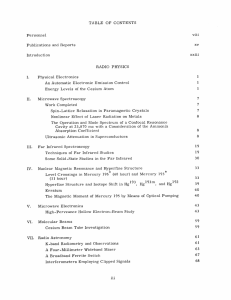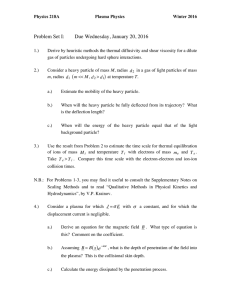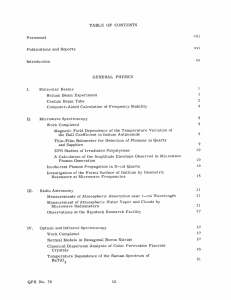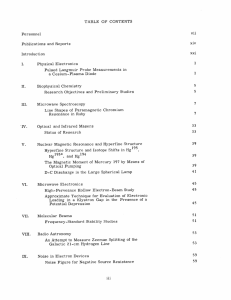VII. RELATIVISTIC BEAMS Academic Research Staff
advertisement
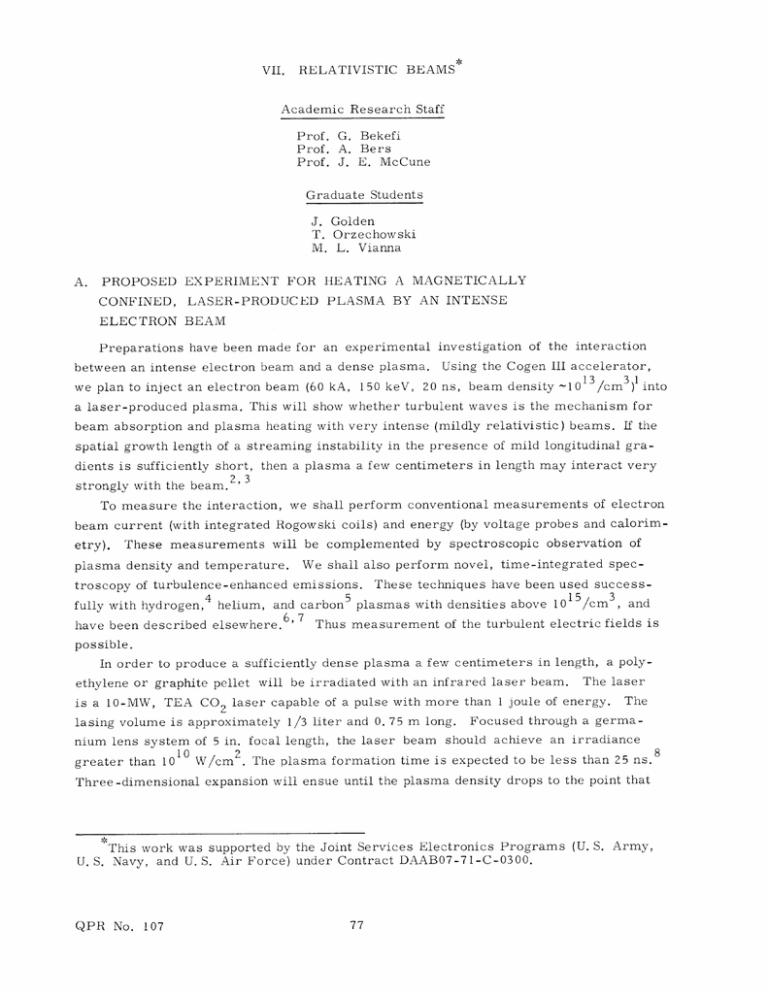
RELATIVISTIC VII. BEAMS Academic Research Staff Prof. G. Bekefi Prof. A. Bers Prof. J. E. McCune Graduate Students J. Golden T. Orzechowski M. L. Vianna A. PROPOSED EXPERIMENT FOR HEATING A MAGNETICALLY CONFINED, LASER-PRODUCED PLASMA BY AN INTENSE ELECTRON BEAM Preparations have been made for an experimental investigation of the interaction between an intense electron beam and a dense plasma. Using the Cogen III accelerator, we plan to inject an electron beam (60 kA, 150 keV, 20 ns, beam density -1013/cm3 ) into a laser-produced plasma. This will show whether turbulent waves is the mechanism for beam absorption and plasma heating with very intense (mildly relativistic) beams. If the spatial growth length of a streaming instability in the presence of mild longitudinal gradients is sufficiently short, then a plasma a few centimeters in length may interact very 2 strongly with the beam. ' 3 To measure the interaction, we shall perform conventional measurements of electron beam current (with integrated Rogowski coils) and energy (by voltage probes and calorimetry). These measurements will be complemented by spectroscopic observation of We shall also perform novel, time-integrated spec- plasma density and temperature. troscopy of turbulence-enhanced emissions. fully with hydrogen,4 helium, and carbon have been described elsewhere. 6 ' 7 5 These techniques have been used success- plasmas with densities above 1015/cm 3, and Thus measurement of the turbulent electric fields is possible. In order to produce a sufficiently dense plasma a few centimeters in length, a polyethylene or graphite pellet will be irradiated with an infrared laser beam. is a 10-MW, TEA CO 2 The laser laser capable of a pulse with more than 1 joule of energy. lasing volume is approximately 1/3 liter and 0. 75 m long. nium lens system of 5 in. greater than 1010 W/cm 2. The Focused through a germa- focal length, the laser beam should achieve an irradiance The plasma formation time is expected to be less than 25 ns. Three-dimensional expansion will ensue until the plasma density drops to the point that This work was supported by the Joint Services Electronics Programs (U. S. Army, U. S. Navy, and U. S. Air Force) under Contract DAAB07-71-C-0300. QPR No. 107 8 (VII. RELATIVISTIC BEAMS) the pressure equals the magnetic field energy density (P3 < 1). Then the plasma will be radially confined in a strong axial magnetic field (10-20 kG, pulsed) to produce a cigarshaped plasma with a radius of a few millimeters (see Fig. VII-1). This plasma should be reproducible and relatively free from spectroscopic impurities. BEAM TARGET: CALORIMETER OR "WITNESS PLATE" SOLENOID I PELLET MAGNETIC FIELD LINES LASERBEAM J ELECTRON BEAM ANODE FOIL CATHODE Fig. VII-1. Experimental arrangement. Because the laser and magnetic field will be capable of a few shots per minute, the data for a target plasma with no electron beam will be amenable to good statistical analysis. A high laser-produced target reliability is requisite because of the low (2/h) repetition rate of the Cogen III system. The major engineering problem is expected to be triggering the plasma and electron beam so that they will coincide. Triggering "jitter" must be well below a few tenths of a microsecond. The magnetic field should raise no difficulty, since its pulse duration will be much greater than the beam-plasma duration. We are about to commence parallel theoretical studies relevant to the experiment. This work will be primarily concerned with the time-space evolution of unstable excitations in a system composed of a beam in an inhomogeneous plasma. G. Bekefi, A. Bers, J. Golden References 1. J. Golden, "Generation of a Very Intense Electron Beam," S. M. Thesis, Department of Aeronautics and Astronautics, M. I. T., 1972 (unpublished); see also Quarterly Progress Report No. 103, Research Laboratory of Electronics, M. I. T. , October 15, 1971, pp. 103-107; Quarterly Progress Report No. 104, January 15, 1972, pp. 191193. QPR No. 107 RELATIVISTIC (VII. J. Briggs, Private communication, BEAMS) 1972. 2. R. 3. J. A. Davis and A. Bers, Proc. Symposium on Turbulence of Fluids and Plasmas, Polytechnic Institute of Brooklyn, April 16-18, 1968 (Polytechnic Institute of Brooklyn 87-108. Press, New York, 1969), pp. 4. C. C. Gallagher and M. A. Levine, Phys. 5. D. D. Burgess, Private communication, 6. G. Bekefi, 7. G. Bekefi, "Advances in Plasma Diagnostics with Waves and Radiation," Proc. Tenth International Conference on Ionization Processes in Plasmas, Oxford, England, September 13-20, 1971 (Donald Parsons and Co., Ltd., Oxford, England, 1972), pp. 299-332. 8. E. B. E. 1972. CALIBRATION Private communication, OF 2708 (1971). Phys. Fluids 14, V. George, and B. Ya'akobi, V. George, 1693 (1971). Letters 27, 1972. SELF-BREAKING, SOLID- STABBED, DIELECTRIC SWITCHES IN THE COGEN III ACCELERATOR A very low inductance switch capable of initially withstanding up to 500 kV is necessary to close the circuit between the transmission line and the beam-producing fieldemission diode of the Cogen III accelerator. 1, 2 techniques in common use for this application. The design of the switch is 3- 6 Since operation of the switch depends on the accelerator geometry and the method of switch manufacture, calibration is 400 r 350 300 250 S I I I I I I 10 20 30 40 50 60 THICKNESS OF REMAINING PLASTIC I 30 25 I I I 20 15 10 5 0 DEPTHOF STAB (mils) Fig. VII-2. QPR No. 107 based on Stabbed-switch calibration curve showing breakdown voltage as a function of stabbing depth per layer. Each layer is a sheet of low-density polyethylene, 60-mil thick. (VII. RELATIVISTIC necessary. BEAMS) During the past quarter, the switches now in use in the Cogen III system have been calibrated. As a result, the voltage switched to the diode can be chosen with a pre- cision of 5% in amplitude and applied with a jitter of -100 ns. Each switch is made of two sheets of low-density polyethylene, approximately 16 in. square. 60-mil thick and An automatic "stabber" (designs made available by cour- tesy of Sandia Laboratories, Inc.) is used to produce conical depressions in one surface of each sheet. This stabber is an air-driven piston with an array of 45 sewing needles, which can be pushed to a precise depth into the plastic. The stabbed holes thus produced will be placed facing the anode side of the switch. A small square of aluminum foil is then rubber-cemented over the stabbed area. Because all of the voltage is applied to one layer of plastic as soon as the other layer breaks down, a very low-inductance, multichanneled switching results. Stab depths of 15 mils per layer produce a switch break- down voltage of 350 kV (see Fig. VII-2.) There was least jitter when the breakdown voltage was well below the peak voltage that would have been obtained by the resonant charging line without a switch breakdown. The worst case occurred when the switch was operated near the top of the charging curve. Since these findings place a limit on the maximum voltage obtainable with low jitter below the maximum voltage (400-500 kV) attainable by the Cogen III system, improved switch operation will be pursued. J. Golden References 1. J. Golden, "Generation of a Very Intense Electron Beam," S. M. Thesis, Department of Aeronautics and Astronautics, M. I. T. , 1972 (unpublished). 2. J. Golden, Quarterly Progress Report No. 103, M. I. T. , October 15, 1971, pp. 103-107. 3. J. J. Clarke and S. August 1969. 4. S. L. Shope, I. D. Smith, G. Yonas, P. Spence, and R. Ward, "Development and Applications of Mylar Striplines," Report No. PIFR-137 DASA-2482, Physics International Company, San Leandro, California, January 1970. 5. L. Bradley (Sandia Laboratories, Albuquerque, tion, 1972. 6. J. C. Martin (Atomic Weapons Research Establishment, Private communication, 1971. QPR No. 107 Linke, Research Laboratory of Electronics, Laboratory of Plasma Studies No. 23, New Mexico), Cornell University, Private communica- Harwell, Berks., U. K. ),
